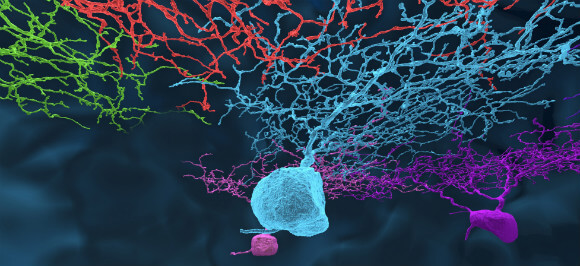Your connectome, the map of all 86 billion connected neurons in your brain, is hopelessly complex. In fact, one human connectome has a staggering 10,000 times that number of neural pathways. Every thought you have and every memory you hold exists in your connectome, and major efforts are under way to map it.
The good news is that you don’t need a fancy neuroscience degree to help out. In fact, the fancy degreed neuroscientists are hoping that you might pitch in.
Created by scientists at MIT, Eyewire is a browser game that lets players take on the challenge of mapping neural pathways in brains — no scientific background required. By playing, gamers are not only mapping neurons, but also training artificial intelligence algorithms to better understand how to map neurons themselves, what Amy Robinson, Creative Director at Eyewire, calls “augmented intelligence”. The more that gamers play, the better the computers get.
In an amplifying way, the team at MIT hopes that these human assisted computers will one day learn to map neurons by themselves.
To date, over 70,000 gamers from over 100 countries have signed up to play Eyewire, and it’s a good thing they did. Using today’s state of the art technology, it takes an AI-assisted researcher almost 50 hours to reconstruct a SINGLE neuron! At that pace, one researcher would need to devote the next 50 million years to neural mapping; no bathroom breaks allowed. Thankfully, there is one thing that technology does consistently overly time, which is improve.
Today our technology improves at the speed of Moore’s Law, and those who study that exponential growth, like Ray Kurzweil, contend that we will not only map the brain in our lifetime, but are only a decade away from doing so. Such ambitious claims are certain to give a neuroscientist the same knee jerk reaction that life scientists had when similar early claims were made about sequencing human genomes.
Five years into the Human Genome Project, it was considered a failure since scientists had completed only 1% of the sequence. Somehow five years after that it was finished. That’s because early on, scientists were required to sequence the genome in linear order. Then, exponentially more powerful computers enabled what’s known as shotgun sequencing, a process that allowed scientists to sequence random strands while computers put those strands back in order; a much faster and simpler process. Better technologies have always improved ways of advancing research.
Mapping the connectome will be considerably more challenging than mapping the genome, but the lesson learned holds true. The key to mapping the connectome will be new technologies and innovative ways of using them.
The team at Eyewire understands this. With their platform, they are enabling a community of citizen scientists who contribute to breakthrough research; something previously restricted to degree holding academics. Additionally, they are leveraging the innate human desire to compete and play games. Considering that as a planet, we spend 3 billion hours playing videogames every week, imagine what can be accomplished when even a portion of that time is allocated to things like neural discovery?
The importance of mapping the brain cannot be overstated. Around the planet, we’re facing an increased prevalence of dementia, mood disorders, and other cognitive disease – an issue that hasn’t gone unnoticed by world leaders. Earlier this year the European Union awarded the Human Brain Project $1.3 Billion over the next ten years while President Obama similarly pledged $100 million of his 2014 fiscal budget to, Brain Research through Advancing Innovative Neurotechnologies, or BRAIN as the project is known.
The post brain mapped world will look nothing like the world of today. A functionally accurate brain map forever changes the equation for everything from medicine to human performance. Cognitive disorders like Alzheimer’s and depression might one day be curable, while brain augmentation through cognitive implants could become commonplace.
At some unforeseen point in the future, researchers will peer into the brain at the resolution of individual synapses and understand what’s happening. In order to get there, scientists must uncover innovative ways of advancing brain science. The supercomputers of the future are a likely candidate to reconstruct all those neurons, but for now they’ll continue to study at the side of Eyewire’s community of scientist gamers.
Why not join the fun? Signup today.
If you’re anxious to learn learn more about the connectome, check out the following TED talk given by EyeWire’s founder, MIT Professor Sebastian Seung:
[Images: EyeWire]




